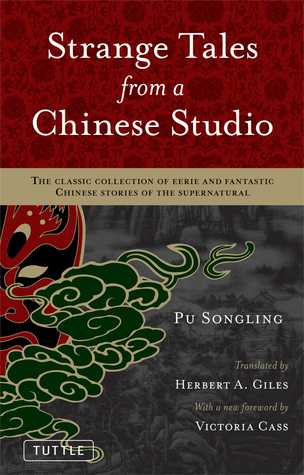 This book was recommended to me from the Overdrive app/NLB ebook site, which is the main reason why my TBR is growing uncontrollably the past few days. Given that I've read very little Chinese fairytales/folklore compared to Western and even Japanese tales, I really wanted to read this book.
This book was recommended to me from the Overdrive app/NLB ebook site, which is the main reason why my TBR is growing uncontrollably the past few days. Given that I've read very little Chinese fairytales/folklore compared to Western and even Japanese tales, I really wanted to read this book.Strange Tales from a Chinese Studio consists of 164 tales from the 17th Century (I think? Author lived during that time) that involve supernatural creatures/occurrences and 4 appendixes.
The appendixes are about:
1. The Yuli Chao Zhuan (a term that seems to appear only in this book but looks to be about the 'chamber of horrors' in Taoist temples
2. Cultural notes on ancestral worship, bi-location, dreams and much more
3. The translator, Herbert Allen Giles
4. Suggested readings.
There are also pretty comprehensive and interesting footnotes, though sadly the book isn't formatted to allow for easy toggling back and forth (pity, especially since this is an ebook).
As for the tales themselves, quite a few of them were very short and I didn't really get them. I did, however, really enjoy the longer tales, especially those about foxes (maybe because I have been writing about foxes?). Stories that I particularly enjoyed include:
The Painted Skin: about a man who 'rescues' a beautiful girl only to find that she's hiding a very dark secret
Miss Yingning; or, The Laughing Girl: a surprisingly happy story
The Virtuous Daughter-in-Law: where a nagging mother-in-law learns to appreciate her daughter in law in a very painful lesson
Danan in Search of his Father: where a family ended up being "reunited" in a way that completely changed the dynamics for the better.
And more that I forgot to bookmark. And I have no idea if I should be providing full summaries with spoilers or doing these attempts at summaries that don't give away the ending :p
While I generally enjoyed the book, it does have its flaws. It was first published in 1908 by a British national which means that the writing is a little stiff and at times uses very Western expressions like:
"You better call in Yunqi, and tell the fair Eloisa that her Aberlard is awaiting her"
Which feels very out of place given that these are Chinese stories set in China.
Still, if you're looking for Chinese folklore to read, it's worth reading this at least once. Most (if not all) of the tales were new to me and I enjoyed reading through the book.
P.s. There is one thing that I don't get. I'm not sure if it's a translation thing but in these stories, people remarry and concubines are bought and sold pretty easily and I'm wondering if this is so. It seems like the concubinage thing might be so but the remarrying thing seems odd.
Anyone familiar with ancient Chinese customs and can let me know more about this/recommend some reading material about it? I did try Googling but I couldn't find much about it.

No comments :
Post a Comment
I really do appreciate all comments, and I'll try my best to reply within 24 hours!
^_^